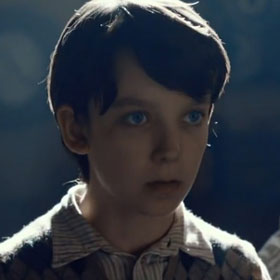Hugo

3/5
Martin Scorsese making a kid’s movie in 3D starring the guy from Borat sounds more like a nightmare world’s April Fool’s prank than a Thanksgiving family offering at the multiplex. Yet, here we find ourselves, where the man most children would know as the guy who directed those movies where the burglar from Home Alone swears a lot looks to get his enchantment on, and in the process becomes the latest big name director to wholeheartedly embrace the dreaded 3D.
An adaptation of the Brian Selznick book – categorized as ‘historical fiction’, being part novel and part educational illustrations – Scorsese’s biggest challenge is the marrying of the two into a fully realized Paris of the 1930’s. From the outset he is not entirely successful, which is a problem since the majority of the story takes place within the confines of an admittedly labyrinthine train station.
Asa Butterfield, in what is a magnificently wounded performance for a child actor, is the eponymous orphan boy dutifully tending to the station’s many clocks while secretly living in some abandoned and forgotten quarters hidden in the walls. His antagonist is a booth dwelling, dourly toymaker, George (Sir Ben Kingsley), from whom he steals the parts he needs to repair his late father’s unfinished automaton. His only friend is the toymaker’s goddaughter (Chloe Moretz) a wide-eyed girl of irrepressible spirit with a fascination with turn-of-the-century fiction. Hugo’s nemesis is the cruel Station Inspector (Sacha Baron Cohen), a wounded war-cripple with a penchant for rounding up strays and shipping them off to the orphanage.
Diving right to the playbook of Jean-Pierre Jeunet – himself weaned on the bizarre French films of the 1930’s – Scorsese emulates the great wizard’s eye for whimsical design flawlessly right down to the bouncy-bounce of accordions, ever present as accompaniment, but lacks his uncanny knack for integrating incidental fringe characters and making them so memorable. Here neither the eccentric courtship of Richard Griffiths and Frances de la Tour (toyed with mercilessly by the whims of her tiny dog), or the presence of Emily Mortimer’s introverted flower girl do much but serve to distract from the central pursuits of Hugo.
But while Hugo walks the walk of a children’s fantasy adventure, as per the novel’s clever interweaving of the real and the imagined the fantastical takes the real world historical form of the marvel of invention, specifically the form and language of cinema itself. To quote the great Sit Arthur C. Clarke: “Any sufficiently advanced technology is indistinguishable from magic.” To that end, history duly notes us that in 1895 when the Lumiere Brothers first showcased a fifty-second clip of a steam train pulling into a station platform, coming towards the camera, audiences leapt up and fled in terror, convinced that the train would burst through the dusty screen and run them all over.
While previous Scorsese projects – most notably The Aviator and The King of Comedy – have brushed up against the medium and the besotted obsessives who toil towards its creation, this is the most overt love letter to cinema in living memory, from Scorsese or anybody else. To say too much would be to spoil the picture’s big reveal, but, suffice to say, it begins with a heart shaped key and ends with a flashback to a glass palace movie studio (so as to permit enough light to film) inside which narrative cinema as we know it today was born – and then cruelly discarded for the arbitrary destruction and sheer vulgarity of war, leaving its defacto inventor a broken man.
It’s enough to make any cinephile weep, but beyond that remains a lingering question as to its potential broader appeal. Children’s mouths all agape with wonder at the sight of silent classics on the silver screen amidst a darkened and hushed auditorium will be duly affecting for those of a certain age, along with anyone who might have gone to film school. But such scenes are likely to leave kids raised on Transformers, Pixar, and the Harry Potter franchise stifling more than a few yawns. Similarly, adults who don’t know their Lumiere from their D. W. Griffith are likely to be left scratching their heads somewhat at clips from The Birth of a Nation, regardless of just how truly revolutionary it was – and it was – back in 1915.
As an adventure story Hugo is somewhat limited in scope, largely confined as it is to the station terminus, and this is never more glaring than during a couple of second-act dream sequences, that are fantastical in the truest sense of the word, that only serve to showcase how different the movie might have been had Scorsese chosen to go definitively in that direction. For the hardcore cinema aficionado this is a picture that will duly delight and astonish in equal measure. For the casual moviegoer – whose only exposure to Melies likely came about via a Smashing Pumpkins music video – it’s perhaps a little too rarefied, and perhaps too Meta to be truly beguiling; a story not best suited to the medium brought about by a director somewhat ill-suited to the genre.
RELATED ARTICLES
Get the most-revealing celebrity conversations with the uInterview podcast!







Leave a comment